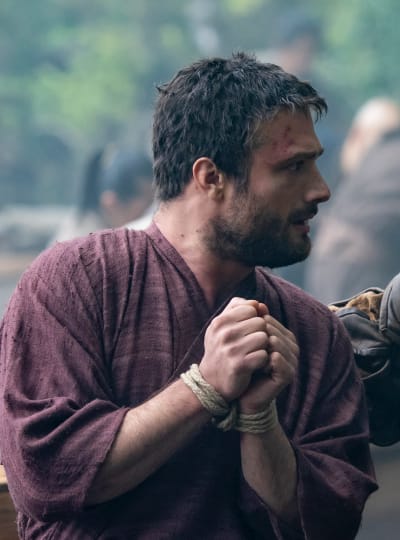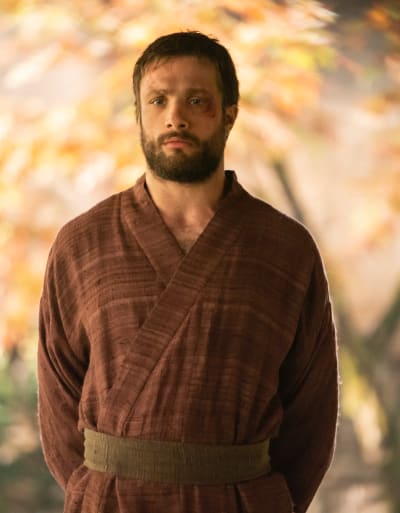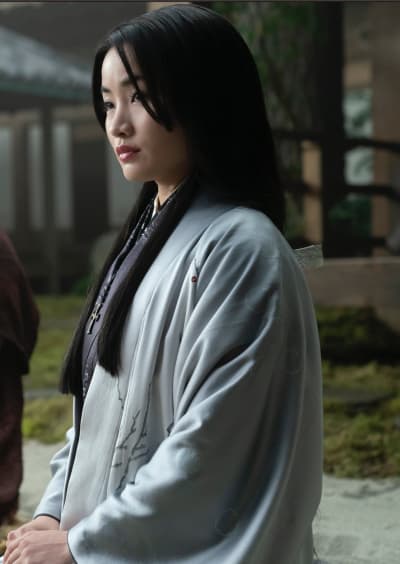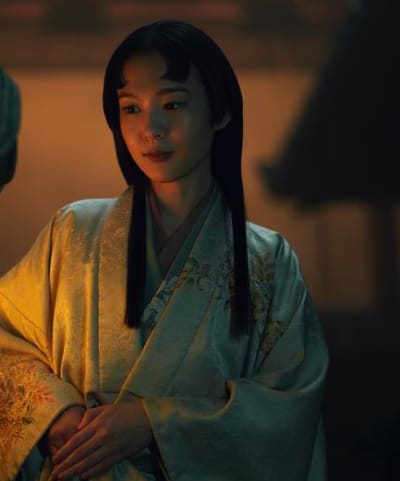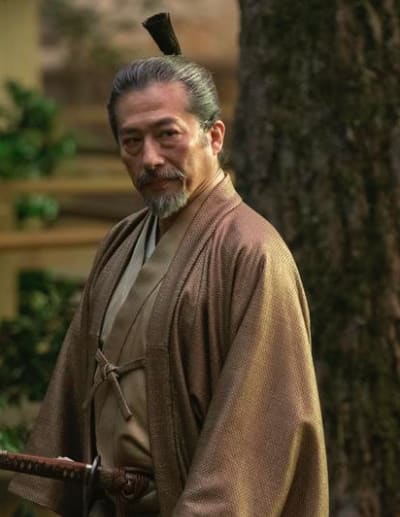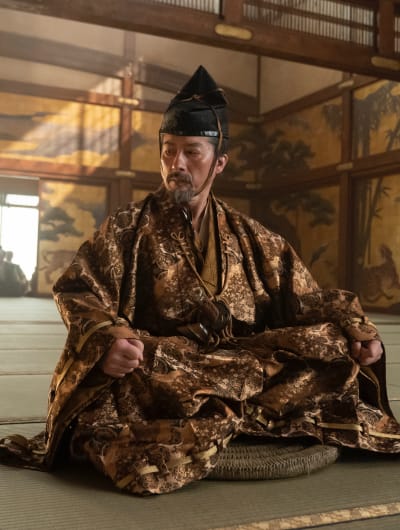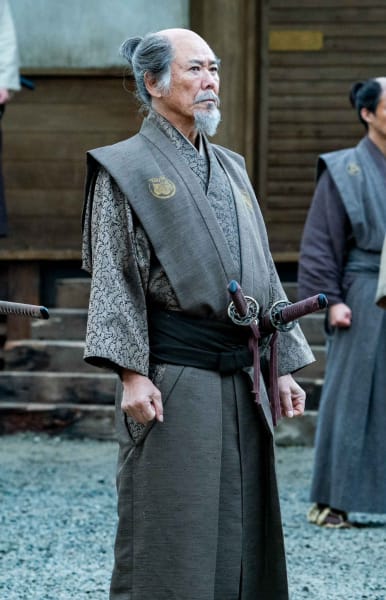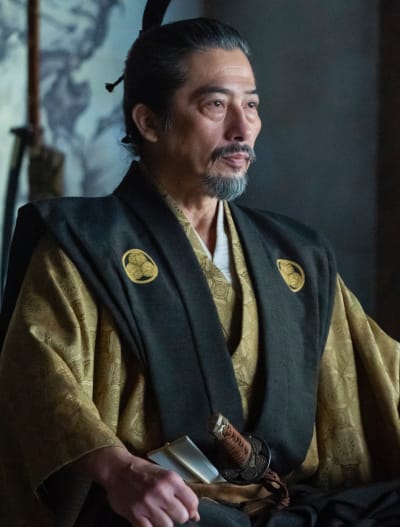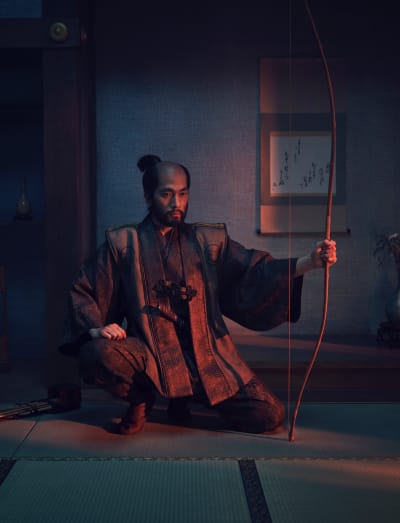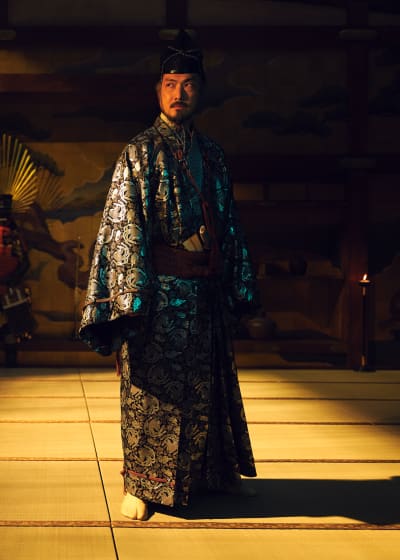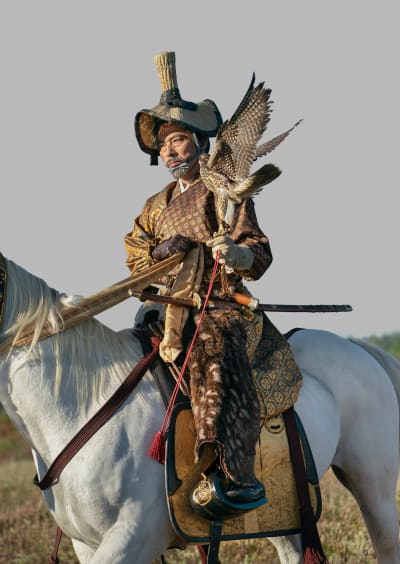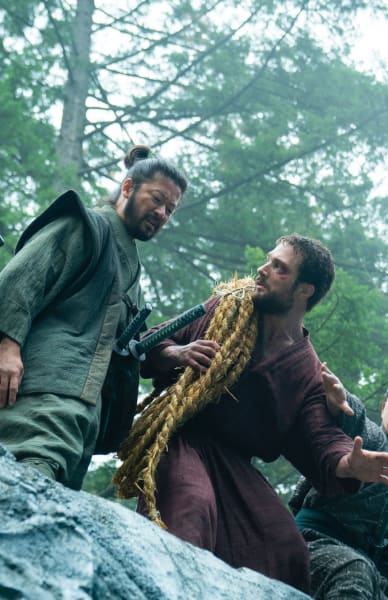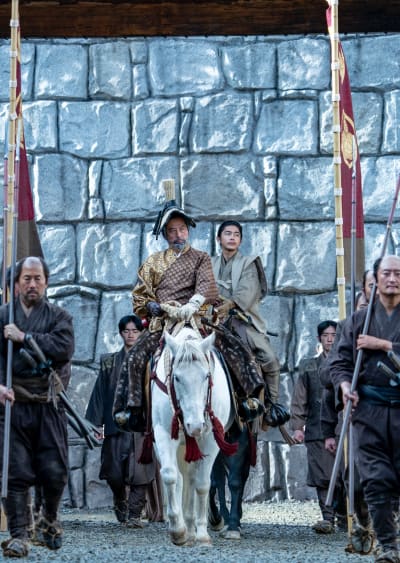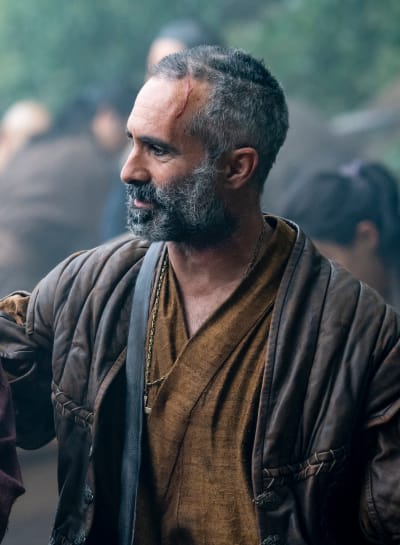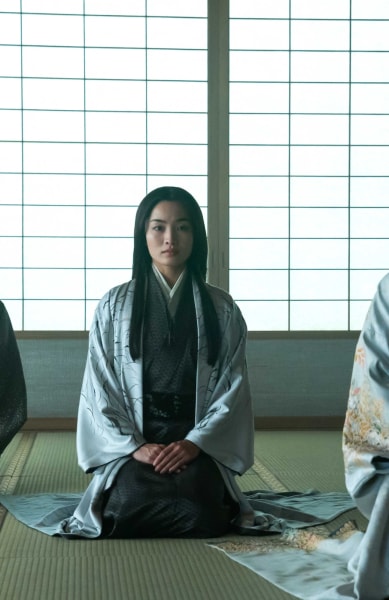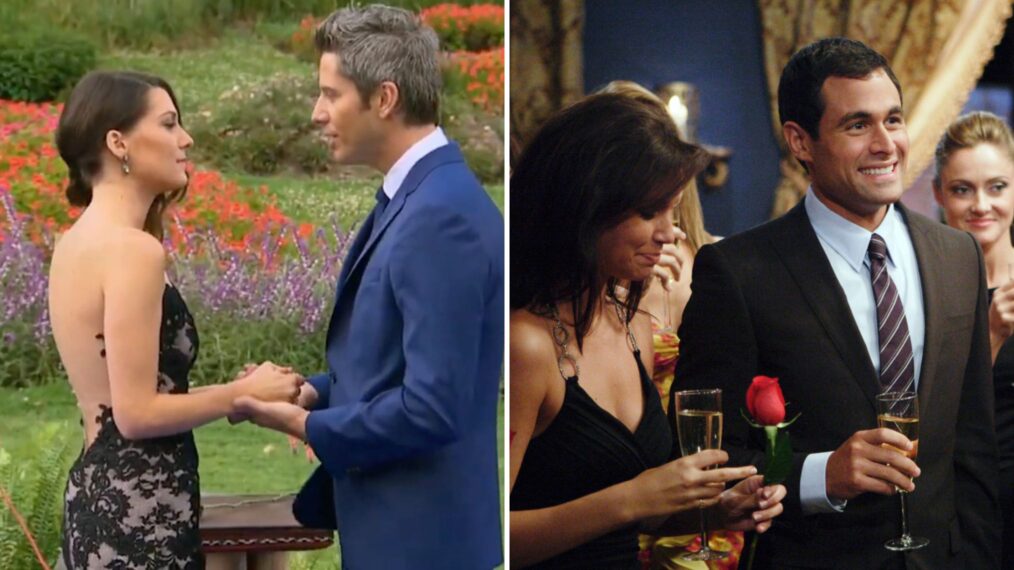Shogun Series Premiere Review: A Violent Clash of Cultures In Feudal Japan
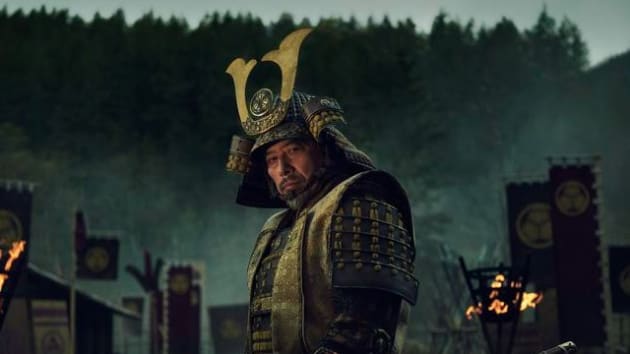
The greatest challenge of every pilot episode (pun, admittedly, intended here, as “anjin” is the Japanese word for “pilot”) is to set the stage for the main action without relying on the sort of awkward information dumps that make viewers feel like they’re watching an adaptation of a Wikipedia page.
Shogun Season 1 Episode 1 cleverly side-steps the usual exposition problems with onscreen text that plunges us into the center of the series’ primary conflicts:
And right off the bat, we realize this adaptation of James Clavell’s beloved 1975 novel is taking us into a high-stakes world of clashing cultures and uneasy alliances.
Portuguese merchants are keeping Japan a secret from the rest of the world, and the five-way beef on the regency council threatens to tear Japan asunder.
As if all that weren’t enough, here comes a ghostly ship loaded with bedraggled Brits and Dutchmen aboard!
A common complaint about many limited series nowadays is that they could’ve/should’ve been feature films (standalone streaming flicks generally don’t boost subscription numbers, so modern execs tend to favor long-form content).
But there’s a reason that Shogun has been adapted twice as a series, and no one has ever attempted a one-off cinematic version.
There’s a lot of story here, and a whole lot of historical context is required to fully appreciate everything that’s happening.
Sure, the ship of the damned crashing into a foreign coast is sort of a cliched jumping-off point these days.
But to be fair, the original Shogun novel and miniseries did much to bring the stranded voyager trope back into the mainstream.
Of course, things have changed quite a bit in the almost 50 years since Clavell’s novel became a cultural phenomenon.
So while the opening chapters of the book primarily concerned themselves with the fish-out-of-water tale of John Blackthorne and his shipmates, showrunners Rachel Kondo and Justin Marks are more interested in jumping right into the rise to power of Lord Toranaga.
Interestingly, that character is much discussed early on in Clavell’s epic, but he doesn’t make his first appearance until around the 250-page mark.
The much earlier introduction is an indicator of showrunners Kondo and Marks’ desire to prioritize the politics of feudal Japan over the story of the shipwrecked Europeans.
It’s a savvy move for multiple reasons. For one thing, OG Shogun-heads have always been in agreement that the Game of Thrones-style maneuvering and machinations are the best parts of Clavell’s tale.
On top of that, a story set in feudal Japan should probably focus on natives of the country, and modern American audiences have hopefully reached a level of sophistication where they don’t need their hands held by Western stand-in characters.
In fact, Kondo and Marks are offering no hand-holding whatsoever, and viewers are thrust into the thick of this tale from the opening scenes.
This is the opposite of the so-called “laundry folding” TV that network execs are apparently gaga for these days, but the astute viewer will themself as swept up by this version of the Shogun saga as millions of readers were by Clavell’s novel in the ’70s.
The conflict between Toranaga and Ishido is laid out in such a way that we immediately understand their history despite few direct references to their past.
And when the embattled Toranaga dispatches Hiromatsu to inspect the mysterious foreign ship, we get just enough sense of where things are headed to whet our appetite without sating it too soon.
We also get a glimpse of how this series will handle some of the more potentially problematic aspects of the original story — namely, the honor killings and ritual suicides that Clavell alleged were an intrinsic aspect of life in feudal Japan.
Kondo and Marks refuse to flinch on that front, delivering a devastating scene in which a mother says goodbye to her infant son, who has been offered up as penance for his father’s social blunder.
The showrunners also refuse to play it safe in their presentation of a memorable scene from early in the novel:
Call it “the pit and the pendulum.” Pilot Blackthorne and his men fail to behave themselves in their underground dungeon, so local samurai badass Omi whips it out and offers his new guest a warm shower.
From there, Blackthorne runs afoul of a Portuguese priest, and we’re reminded of just what a big, brutal, complex world we live in.
The pilot realizes that the dispute between British-Dutch and Spanish-Portuguese interests is as arcane to his captors as the beef within the Regents Council would be to his mates back home.
Again, the most impressive feat that Kondo and Marks pull off here is conveying all of this not only as information but as emotional actuality. We’re not only aware of what’s going on, we feel it every step of the way. It’s dense material, but it’s handled with amazing dexterity.
The titular line is delivered in a scene that informs us of the special relationship between Toranaga and the Heir — and in which, as a bonus, every damn frame looks like a gorgeous painting.
The beauty and poignancy of that scene are contrasted by what’s referred to in the books as the Night of the Screams.
One of Blackthorne’s shipmates is tortured to death, and while we’re spared none of his agony, the showrunners resist the urge to linger gratuitously on the visuals of his demise.
Instead, they use the scene to reveal character: visiting mid-tier lord Kashigi Yabushige, we learn, is a man who likes to watch — be it another man’s death, or another man’s “little death” in the presence of a concubine.
One scene of naked indulgence is contrasted with another as a nude, bootless, and newly shorn Blackthorne eats with his hands and attempts to get to the bottom (teehee) of last night’s screams.
We’re reminded yet again that Kondo and Marks possess a talent for using visuals to convey essential plot information that we haven’t seen on television in quite some time.
Yabushige explains his plan to Omi just as Hiromatsu arrives — and promptly lays waste to that plan by explaining that the ship and all its contents belong to Toranaga.
And the introduction of Spanish pilot Vasco Rodrigues — a fan favorite from the books — is handled with an appropriate level of aplomb.
He saunters onto the scene and cracks wise before ferrying Blackthorne off to Osaka to meet with Toranaga.
Let’s pause for a moment to catch our breath and acknowledge that there’s a whole lot of plot going on here — so much, in fact, that some viewers might find it all a bit overwhelming.
The complex hierarchical power structure of feudal Japan, the esoteric entangled alliances of various European nations as they stake their claims in the New World …
When we compared this show to Game of Thrones earlier, we probably should’ve clarified that it’s like Game of Thrones, plus a dash of Deadwood, with a little bit of eighth-grade social studies mixed in.
But so far, the rewards are well worth the effort, and this story only deepens and intensifies as it progresses.
Plus, we get the occasional storm at sea setpiece — a doozy, in this case, the sort of thing that would’ve been unimaginable on a TV budget a scant 15 years ago — to break up all that plotting, scheming, and unreliable translating.
That said, folks who have read Clavell’s novel might feel as though they’re benefitting from a secret rutter that enables them to navigate the tricky waters of Shogun’s sometimes labyrinthine plot.
And in the world of this series, even storms at sea lead to psychologically complex battles of wills.
Rodrigues is swept from the deck and dashed on the rocks, and Blackthorne is able to manipulate the situation so that Yabushige feels that he has no choice but to go rescue the battered pilot.
The mores of the time are visually explicated in memorable fashion, as Yabushige nearly takes his own life during the rescue attempt but winds up making it back to shore and earning Blackthorne’s respect in the process.
Those values are underscored in the following scene, when Lady Mariko informs Toranaga that should he lose his battle with the Council of Regents, his supporters will check out along with him.
Mariko is torn between her Christian faith and her loyalty to her culture. When Toranaga explains to her that the Blackthorne is a kind of Westerner heretofore unseen in the East, the scene beautifully weaves together plot strands and subtextual themes that seemed only tenuously linked before.
Conflicting philosophies come to the forefront again as Blackthorne argues for the virtue of railing against one’s circumstances while the mangled Rodrigues preaches the acceptance of one’s fate.
As Rodrigues waxes philosophical, Blackthorne begins to realize that the “barbarian” label he’s been carrying since his arrival might be more accurate than he’d realized (he hadn’t exactly sailed to the new world to make friends, after all).
A sweeping shot of feudal Osaka concludes with Blackthorne bowing before Toranaga, and the deftness with which this pilot (the episode, not the beleaguered Brit) handled such complex material leaves us as awed as any of the stunning visuals delivered by director Jonathan Van Tulleken.
But wait! In a somewhat surprising programming decision — especially considering how much was crammed into that first episode — FX decided to air Shogun Season 1 Episode 2 directly after the pilot.
So like a proud samurai rescuing a shipwrecked sailor, let’s dive in!
After a premiere that sped us through nearly 300 pages of Clavell’s text (the book is the sort of dense tome that bodybuilders might try to tear in half as a feat of strength, so we may see such breakneck pacing throughout the series), we go back in time to the Osaka of one year prior.
The Taiko is breathing his last breath, thus setting the stage for the rule of his young heir and the regency conflicts to follow.
He summons Toranaga to his side and offers him the role of sole regent in exchange for a promise of his son’s safety.
Plan B is the five-man Council of Regents we see now, a cutthroat group tasked with ruling the country until the heir, Yeachiyo, turns 16.
Following an open credits sequence that once again delivers big-time Game of Thrones vibes (That’s not a complaint! Let’s not forget how much we all loved that show at one point!) we return to the present day.
As Blackthorne continues to kneel before Toranaga, his pseudo-friend Rodrigues disparages him in a meeting with local Portuguese priests.
Their original plan is to hang Blackthorne for the crimes described in his rutters — but doing so would require them to translate the books for Toranaga, who might benefit from the knowledge therein.
From there, we’re treated to a trilingual exchange of hostilities and appeasement that’s as thrilling as any shipwreck scene that came before it.
In addition to the tension between these foreign rivals, we pick up on Mariko’s attraction to Blackthorne, which sets the stage for a potential love triangle between the two of them and her husband, the vicious Banturo.
But Mariko is no mere one-note love interest. In addition to her knowledge of foreign languages, she’s the first to piece together Toranaga’s plan to use Blackthorne to sow discord among the Christians on the Council of Regents.
A fellow prisoner explains the political unrest to Blackthorne, who finally begins to grasp the gravity of his situation.
The pilot realizes suddenly that his host Toranaga is in a state just as precarious as his own. The trope of rivals forced into an unlikely allyship is another common one, but rarely has it been executed so deftly.
Toranaga’s gambit pays off as the regents demand that Lord Ishido put the Protestant heretic to death before any action is taken on the Toranaga front.
In one of the few scenes in which the writers give into the urge toward clunky exposition, the imprisoned priest spins a compelling yarn for Blackthorne:
Toranaga is a threat due to his Minowara ancestry, which gives him claim to the title of Shogun, and the Portuguese Catholic Church controls all trade in and out of Japan.
A conversation between Ishido and Yabushige winds up saving Blackthorne’s life when the Toranaga rivals decide to rescue the barbarian from execution after realizing that he might be of use to them.
It’s a bit of a deus ex machina moment, but for a tale of adventure of this scale, we’re willing to suspend our disbelief now and then.
From there, Blackthorne is given the opportunity to plead his case to Toranaga.
He reveals the existence of secret Portuguese bases in China and explains that Portugal and Spain intend to claim the whole of Asia and the Americas for themselves.
He claims that England would like to be an ally to Japan, and the scope of the global conflict begins on dawn on Toranaga.
It’s a thrilling scene, as the roles are reversed, and now Blackthorne is in the position of explaining a complex political situation.
As Toranaga expresses his misgivings to his translator-priest Alvito, we realize that Shogun has accomplished the near-impossible by setting the stage for a multi-faceted epic conflict without ever making us feel as though we were waiting for the real story to begin.
The internal logic and thematic interests of this story are so well-defined that a violent assassination attempt that solidifies the bond between Blackthorne and Toranaga becomes the rare jaw-dropping twist that also makes perfect sense in retrospect.
These opening episodes were thrilling beyond measure, and better yet, they concluded with the promise of even higher stakes to come.
What did you think, TV Fanatics?
Were you as blown as we were by the first two episodes of Shogun?
Hit the comments section below to share your thoughts.
Tyler Johnson is an Associate Editor for TV Fanatic and the other Mediavine O&O sites. In his spare time, he enjoys reading, cooking, and, of course, watching TV. You can Follow him on X and email him here at TV Fanatic.
Read the original article here



